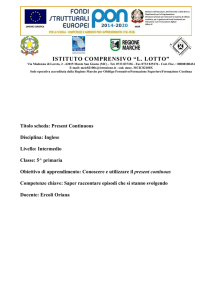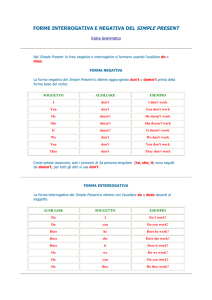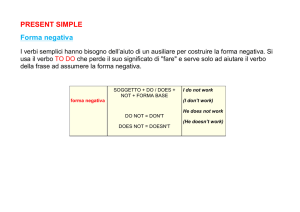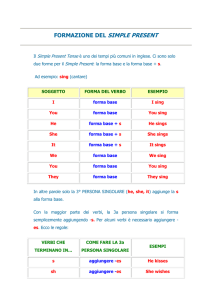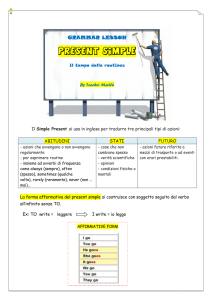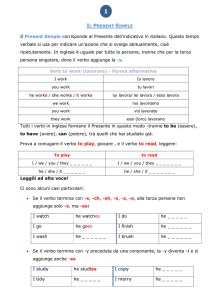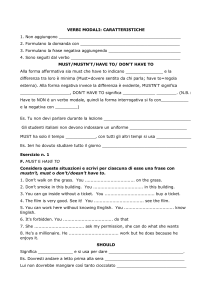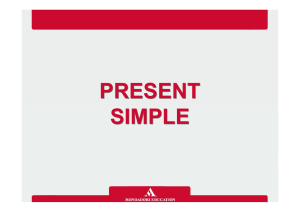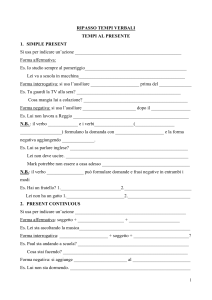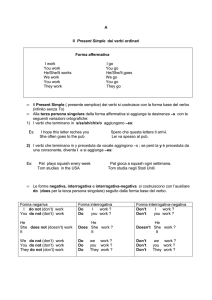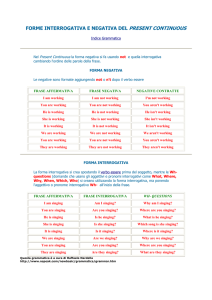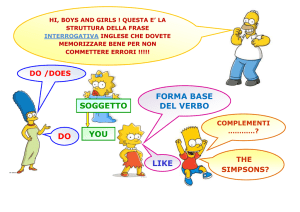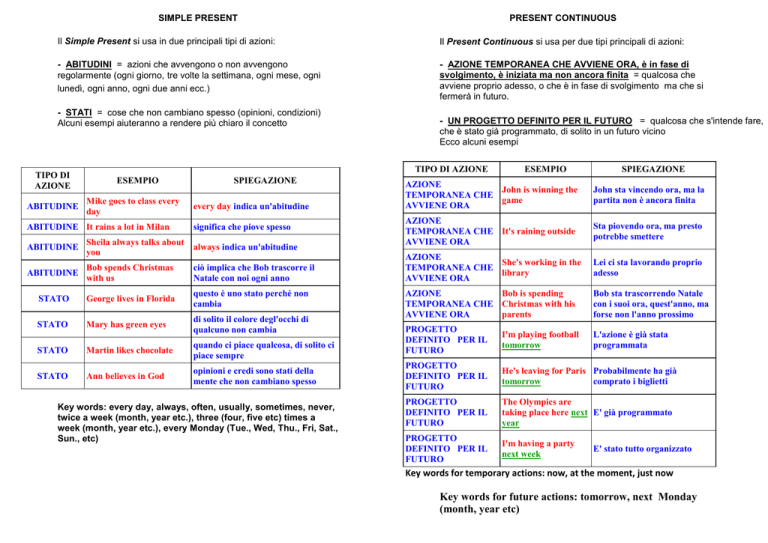
SIMPLE PRESENT
PRESENT CONTINUOUS
Il Simple Present si usa in due principali tipi di azioni:
Il Present Continuous si usa per due tipi principali di azioni:
- ABITUDINI = azioni che avvengono o non avvengono
regolarmente (ogni giorno, tre volte la settimana, ogni mese, ogni
lunedì, ogni anno, ogni due anni ecc.)SE
- AZIONE TEMPORANEA CHE AVVIENE ORA, è in fase di
svolgimento, è iniziata ma non ancora finita = qualcosa che
avviene proprio adesso, o che è in fase di svolgimento ma che si
fermerà in futuro.
- STATI = cose che non cambiano spesso (opinioni, condizioni)
Alcuni esempi aiuteranno a rendere più chiaro il concetto
TIPO DI
AZIONE
TIPO DI AZIONE
ESEMPIO
SPIEGAZIONE
Mike goes to class every
ABITUDINE
day
every day indica un'abitudine
ABITUDINE It rains a lot in Milan
significa che piove spesso
ABITUDINE
- UN PROGETTO DEFINITO PER IL FUTURO = qualcosa che s'intende fare,
che è stato già programmato, di solito in un futuro vicino
Ecco alcuni esempi
Sheila always talks about
you
Bob spends Christmas
ABITUDINE
with us
always indica un'abitudine
ciò implica che Bob trascorre il
Natale con noi ogni anno
STATO
George lives in Florida
questo è uno stato perché non
cambia
STATO
Mary has green eyes
di solito il colore degl'occhi di
qualcuno non cambia
STATO
Martin likes chocolate
quando ci piace qualcosa, di solito ci
piace sempre
STATO
Ann believes in God
opinioni e credi sono stati della
mente che non cambiano spesso
Key words: every day, always, often, usually, sometimes, never,
twice a week (month, year etc.), three (four, five etc) times a
week (month, year etc.), every Monday (Tue., Wed, Thu., Fri, Sat.,
Sun., etc)
ESEMPIO
SPIEGAZIONE
AZIONE
John is winning the
TEMPORANEA CHE
game
AVVIENE ORA
John sta vincendo ora, ma la
partita non è ancora finita
AZIONE
TEMPORANEA CHE It's raining outside
AVVIENE ORA
Sta piovendo ora, ma presto
potrebbe smettere
AZIONE
She's working in the
TEMPORANEA CHE
library
AVVIENE ORA
Lei ci sta lavorando proprio
adesso
AZIONE
Bob is spending
TEMPORANEA CHE Christmas with his
AVVIENE ORA
parents
Bob sta trascorrendo Natale
con i suoi ora, quest'anno, ma
forse non l'anno prossimo
PROGETTO
DEFINITO PER IL
FUTURO
I'm playing football
tomorrow
L'azione è già stata
programmata
PROGETTO
DEFINITO PER IL
FUTURO
He's leaving for Paris Probabilmente ha già
tomorrow
comprato i biglietti
PROGETTO
DEFINITO PER IL
FUTURO
The Olympics are
taking place here next E' già programmato
year
PROGETTO
DEFINITO PER IL
FUTURO
I'm having a party
next week
E' stato tutto organizzato
Key words for temporary actions: now, at the moment, just now
Key words for future actions: tomorrow, next Monday
(month, year etc)
FORMAZIONE DEL SIMPLE PRESENT
FORMAZIONE DEL PRESENT CONTINUOUS (o PROGRESSIVE)
TENSE
Il Simple Present Tense è uno dei tempi più comuni in inglese.
Ci sono solo due forme per il Simple Present: la forma base e
la forma base + s.
In questa tabella la coniugazione del verbo to sing (cantare)
Il Present Continuous Tense (chiamato anche Present
Progressive Tense) ècomunemente usato in inglese per descrivere
azioni che si stanno svolgendo in questo preciso momento, o
programmate nel futuro.
Questo tempo viene formato usando due componenti: il presente
SOGGETTO
FORMA DEL VERBO
ESEMPIO
I
forma base
I sing
You
forma base
You sing
He
forma base + s
He sings
She
forma base + s
She sings
SOGGETTO
VERBO ESSERE
FORMA -ING DEL
VERBO
It
forma base + s
It sings
I
am
working
We
forma base
We sing
You
are
working
You
forma base
You sing
He
is
working
They
forma base
They sing
She
is
working
It
is
working
We
are
working
You
are
working
They
are
working
In altre parole solo la 3° PERSONA SINGOLARE (he, she, it)
aggiunge la s alla forma base.
Con la maggior parte dei verbi, la 3a persona singolare si forma
semplicemente aggiungendo -s.
Per alcuni verbi è necessario aggiungere -es.
Ecco le regole:
VERBI CHE
TERMINANO IN...
COME FARE LA 3a PERSONA
SINGOLARE
ESEMPI
s
aggiungere -es
He kisses
sh
aggiungere -es
She wishes
ch
aggiungere -es
He watches
x
aggiungere -es
She mixes
z
aggiungere -es
She buzzes
o
aggiungere -es
He goes
consonante + y
cambiare la y in i e aggiungere -es
It flies
(to be)
semplice del verbo essere
e la forma -ing del verbo
di cui si vuole formare il presente progressivo.
COME CREARE LA FORMA -ING DEI VERBI
Con molti verbi basta aggiungere -ing alla forma base, con altri è
necessario cambiare un po' la parte finale
VERBI CHE
TERMINANO IN...
COME CREARE LA FORMA ING
ESEMPI
1 vocale + 1 consonante
raddoppiare la
consonante eaggiungere -ing
swim - swimming
get - getting
1 vocale + 1 consonante rimuovere la e, poi aggiungere +e
ing
tutti gli altri
aggiungere -ing
come - coming
live - living
go - going
say - saying
FORME INTERROGATIVA E NEGATIVA DEL SIMPLE PRESENT
Nel Simple Present le frasi negative e interrogative si formano
usando l'ausiliare do odoes.
FORME INTERROGATIVA E NEGATIVA DEL PRESENT
CONTINUOUS (PROGRESSIVE) TENSE
Nel Present Continuous la forma negativa si fa usando not e quella
interrogativa cambiando l'ordine delle parole della frase.
FORMA NEGATIVA
FORMA NEGATIVA
La forma negativa del Simple Present si ottiene
aggiungendo don't o doesn't prima della forma base del verbo:
SOGGETTO
AUSILIARE
FORMA BASE
ESEMPIO
I
don't
work
I don't work
You
don't
work
You don't work
He
doesn't
work
He doesn't work
She
doesn't
work
She doesn't work
It
doesn't
work
It doesn't work
We
don't
work
We don't work
You
don't
work
You don't work
work
They
don't
They don't work
Come potete osservare, solo i pronomi di 3a persona singolare (he, she, it)
sono seguiti da doesn't, per tutti gli altri si usa don't.
FORMA INTERROGATIVA
La forma interrogativa del Simple Present si ottiene con
l'ausiliare do o does davanti al soggetto, cui segue poi la forma base
del verbo.
Le negative sono formate aggiungendo not o n't dopo il verbo
essere
FRASE AFFERMATIVA
FRASE NEGATIVA
NEGATIVE
CONTRATTE
I am working
I am not working
I'm not working
You are working
You are not working
You aren't working
He is working
He is not working
He isn't working
She is working
She is not working
She isn't working
It is working
It is not working
It isn't working
We are working
We are not working
We aren't working
You are working
You are not working
You aren't working
They are working
They are not working
They aren't working
FORMA INTERROGATIVA
La forma interrogativa si crea spostando il verbo essere prima del soggetto, mentre
leWh- questions (domande che usano gli aggettivi e pronomi interrogativi
come What, Where, Why, When, Which, Who) si creano utilizzando la forma
interrogativa, ma ponendo l'aggettivo o pronome interrogativo Wh- all'inizio della
frase.
FRASE
FRASE AFFERMATIVA
WH- QUESTIONS
INTERROGATIVA
AUSILIARE
SOGGETTO
FORMA BASE
ESEMPIO
I am singing
Am I singing?
Why am I singing?
Do
I
work
Do I work?
You are singing
Are you singing?
Where are you singing?
Do
you
work
Do you work?
He is singing
Is he singing?
What is he singing?
Does
he
work
Does he work?
She is singing
Is she singing?
Which song is she singing?
Does
she
work
Does she work?
It is singing
Is it singing?
Where is it singing?
Does
it
work
Does it work?
We are singing
Are we singing?
Why are we singing?
Do
we
work
Do we work?
You are singing
Are you singing?
Where are you singing?
Do
you
work
Do you work?
They are singing
Are they singing?
What are they singing?
Do
they
work
Do they work?
FORMA INTERROGATIVA-NEGATIVA
La forma interrogativa-negativa del Simple Present si ottiene con
l'ausiliare don't odoesn't davanti al soggetto, segue poi la forma
base del verbo
AUSILIARE
SOGGETTO
FORMA BASE
ESEMPIO
Don't
I
work
Don't I work?
Don't
you
work
Don't you work?
Doesn't
he
work
Doesn't he work?
Doesn't
she
work
Doesn't she work?
Doesn't
it
work
Doesn't it work?
Don't
we
work
Don't we work?
Don't
you
work
Don't you work?
Don't
they
work
Don't they work?
SHORT ANSWERS - RISPOSTE BREVI
Le Short Answers sono brevi risposte date a domande che prevedono in
genere un SI' o un No e sono preferite alle risposte secche (SI'/NO). Si
formano al presente semplice utilizzando, dopo YES o NO, il soggetto
sempre in forma di pronome personale seguito
da DO/DON'T o DOES/DOESN'T. Eccone degli esempi:
YES/NO QUESTIONS - DOMANDE SI'/NO
SHORT ANSWERS
Do they work in London?
Yes, they do
No, they don't
Do George and Michael work in London?
Yes, they do
No, they don't
Does he drive to work?
Yes, he does
No, he doesn't
Does Bob drive to work?
Yes, he does
No, he doesn't
FORMAZIONE DELLE WH- QUESTIONS
Le Wh- questions (domande che usano aggettivi e pronomi
interrogativi come What, Where, Why, When, Which, Who) si
formano ponendo l'aggettivo o pronome interrogativo Wh- all'inizio
della frase interrogativa. Eccone degli esempi:
AFFERMATIVA
INTERROGATIVA
WH- QUESTIONS
They work
Do they work?
Why do they work?
You study
Do you study?
What do you study?
She drives
Does she drive?
Which car does she drive?

